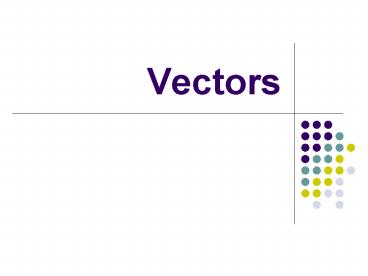Vectors - PowerPoint PPT Presentation
Title: Vectors
1
Vectors
2
There are two kinds of quantities
- Scalars are quantities that have magnitude only,
such as - position
- speed
- time
- mass
- Vectors are quantities that have both magnitude
and direction, such as - displacement
- velocity
- acceleration
3
Notating vectors
- This is how you notate a vector
- This is how you draw a vector
4
Direction of Vectors
- Vector direction is the direction of the arrow,
given by an angle. - This vector has an angle that is between 0o and
90o.
5
Vector angle ranges
6
BUTwhat about the direction?
- In the previous example, DISPLACEMENT was asked
for and since it is a VECTOR we should include a
DIRECTION on our final answer.
N
W of N
E of N
N of E
N of W
E
W
N of E
S of W
S of E
NOTE When drawing a right triangle that conveys
some type of motion, you MUST draw your
components HEAD TO TOE.
W of S
E of S
S
7
Equal Vectors
- Equal vectors have the same length and direction,
and represent the same quantity (such as force or
velocity). - Draw several equal vectors.
8
Inverse Vectors
- Inverse vectors have the same length, but
opposite direction. - Draw a set of inverse vectors.
9
Sample problem
- A surveyor stands on a riverbank directly across
the river from a tree on the opposite bank. She
then walks 100 m downstream, and determines that
the angle from her new position to the tree on
the opposite bank is 50o. How wide is the river,
and how far is she from the tree in her new
location?
10
Sample problem
- You are standing at the very top of a tower and
notice that in order to see a manhole cover on
the ground 50 meters from the base of the tower,
you must look down at an angle 75o below the
horizontal. If you are 1.80 m tall, how high is
the tower?
11
Practice Problem
- Find the x- and y-components of the following
vectors - R 175 meters _at_ 55o
12
Practice Problem
- Find the x- and y-components of the following
vectors - v 25 m/s _at_ 178o
13
Practice Problem
- Find the x- and y-components of the following
vectors - a 2.23 m/s2 _at_ 50o N of W
14
Graphical Addition of Vectors
15
Graphical Addition of Vectors
- Add vectors A and B graphically by drawing them
together in a head to tail arrangement. - Draw vector A first, and then draw vector B such
that its tail is on the head of vector A. - Then draw the sum, or resultant vector, by
drawing a vector from the tail of A to the head
of B. - Measure the magnitude and direction of the
resultant vector.
16
Practice Graphical Addition
A B R
R is called the resultant vector!
17
The Resultant and the Equilibrant
- The sum of two or more vectors is called the
resultant vector. - The resultant vector can replace the vectors from
which it is derived. - The resultant is completely canceled out by
adding it to its inverse, which is called the
equilibrant.
18
The Equilibrant Vector
A B R
The vector -R is called the equilibrant. If you
add R and -R you get a null (or zero) vector.
19
Graphical Subtraction of Vectors
- Subtract vectors A and B graphically by adding
vector A with the inverse of vector B (-B). - First draw vector A, then draw -B such that its
tail is on the head of vector A. - The difference is the vector drawn from the tail
of vector A to the head of -B.
20
Practice Graphical Subtraction
A - B C
21
Practice Problem
- Vector A points in the x direction and has a
magnitude of 75 m. Vector B has a magnitude of 30
m and has a direction of 30o relative to the x
axis. Vector C has a magnitude of 50 m and points
in a direction of -60o relative to the x axis. - Find A B
- Find A B C
- Find A B.
22
Practice Problem
- In a daily prowl through the neighborhood, a cat
makes a displacement of 120 m due north, followed
by a displacement of 72 m due west. Find the
magnitude and displacement required if the cat is
to return home.
23
Practice Problem
- If the cat in the previous problem takes 45
minutes to complete the first displacement and 17
minutes to complete the second displacement, what
is the magnitude and direction of its average
velocity during this 62-minute period of time?
24
Relative Motion
25
Relative Motion
- Relative motion problems are difficult to do
unless one applies vector addition concepts. - Define a vector for a swimmers velocity relative
to the water, and another vector for the velocity
of the water relative to the ground. Adding those
two vectors will give you the velocity of the
swimmer relative to the ground.
26
Relative Motion
27
Relative Motion
28
Relative Motion
29
Practice Problem
- You are paddling a canoe in a river that is
flowing at 4.0 mph east. You are capable of
paddling at 5.0 mph. - If you paddle east, what is your velocity
relative to the shore? - If you paddle west, what is your velocity
relative to the shore? - You want to paddle straight across the river,
from the south to the north.At what angle to you
aim your boat relative to the shore? Assume east
is 0o.
30
Practice Problem
- You are flying a plane with an airspeed of 400
mph. If you are flying in a region with a 80 mph
west wind, what must your heading be to fly due
north?

